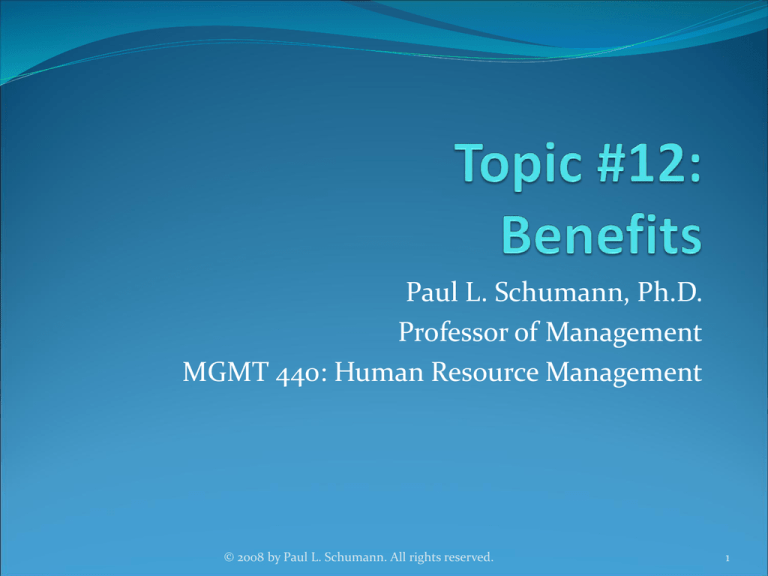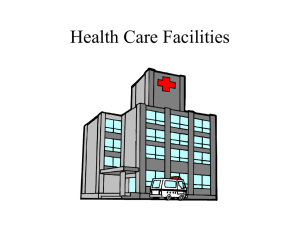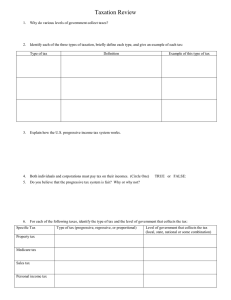
Paul L. Schumann, Ph.D.
Professor of Management
MGMT 440: Human Resource Management
© 2008 by Paul L. Schumann. All rights reserved.
1
Outline
Pay for Time Not Worked
Mandatory Protection Programs
Optional Protection Programs
Other Benefits
2
Pay for Time Not Worked
Paid holidays
Paid holidays are not required by law in the US — it’s up to
the company whether to have them & (if so) how to do it
Number of paid holidays
Which specific holidays
Examples: New Years’ Day, Memorial Day, Independence Day,
Labor Day, Thanksgiving Day
How to compensate employees who have to work on a paid holiday
Extra pay
Example: Pay hourly workers double-time if they work on a
paid holiday
Compensating time off
Example: If some employees work on a paid holiday, they get a
paid day off on a day of their choice (subject to approval)
3
Pay for Time Not Worked
Paid vacations
Paid vacations are not required by law in the US — it’s up to
the company
Length of paid vacations
Example:
After 1 year of service = 2 weeks
After 5 years of service = 3 weeks
After 10 years of service = 4 weeks
After 20 years of service = 5 weeks
How do employees request the dates for their vacation?
Seniority?
Example: employee with the most seniority picks dates first
Do part-time employees get paid vacations?
4
Pay for Time Not Worked
Paid sick leave
Paid sick leave is not required by law in the US — it’s up to
the company
How will employees accrue sick leave time?
Example: accrue 1 sick leave day for each month worked
What happens to unused sick leave time at end of year?
Use it or lose it
Problem: employees may use up unused sick days before they
lose them
Roll over unused sick leave days to the next year
What happens to accrued sick leave when employee leaves?
Use it or lose it
Cash out the number of unused sick leave days
5
Pay for Time Not Worked
Paid personal days
Paid personal days are not required by law in the US — it’s up
to the company
How will the employee accrue paid personal days?
Example: 3 personal days per year
What happens to unused personal days at end of year?
Use it or lose it
Roll over unused personal days to the next year
What happens to unused personal days when employee leaves?
Use it or lose it
Cash out the number of unused personal leave days
Some organizations have dropped the distinction between
sick days & personal days, and just use personal days
6
Pay for Time Not Worked
Family and Medical Leave Act
Covered employers must grant eligible employees up to 12
weeks of unpaid leave during a 12 month period because of:
Birth & care of a newborn child of the employee
Arrival with the employee of a son or daughter by adoption or foster
care
Care of an immediate family member (spouse, child, or parent) with
a serious medical condition
Employee’s own serious medical condition
While the required leave is unpaid, the employer must
continue any medical benefits
Employee is entitled to the same or an equivalent job on
return to work
http://www.dol.gov/esa/whd/fmla/
7
Pay for Time Not Worked
Uniformed Services Employment & Reemployment
Rights Act (USERRA)
Protects the civilian job rights & benefits of employees
who serve in the US uniformed services (Army, Navy,
Marine Corps, Air Force, Coast Guard, National Guard,
including employees who are in the Reserves who are
called up to active duty)
http://www.dol.gov/compliance/laws/comp-userra.htm
8
Mandatory Protection Programs
Unemployment Compensation Insurance
Insurance that pays temporary partial wage replacement to
laid off workers who are actively looking for a job
Applies only to laid off workers
Workers who quit or are terminated for cause are not eligible
Up to 26 weeks of benefits (sometimes extended by law)
Premiums are paid by the company
Premiums are experience-rated: more layoffs higher premiums
Amount of benefits varies by state
Weekly benefit is typically a percentage of the worker’s pre-layoff
pay, subject to a maximum weekly amount
Minnesota: http://www.uimn.org
Weekly benefit = about 50% of employee’s average weekly wage
Maximum weekly benefit (2008) = $538
9
Mandatory Protection Programs
Workers’ Compensation
No fault insurance that pays benefits to employees who suffer
an on-the-job injury (or death)
Benefit rules & amounts vary by state
Typical benefits:
Cost of medical care for the work injury
Wage-loss because of the work injury
Temporary total disability
Temporary partial disability
Permanent total disability
Permanent partial disability
Premiums are experience-rated & paid by the company
Minnesota: http://www.doli.state.mn.us/workcomp.html
10
Mandatory Protection Programs
Social Security
Social Security Administration (SSA): http://www.ssa.gov/
Types of benefits (5 main types):
Retirement benefits: income benefits for retired workers
Age to qualify for full retirement benefits depends on year of birth
Penalty (reduced benefits) if retire before full retirement age
http://www.ssa.gov/retire2/agereduction.htm
Amount of monthly retirement benefits depends on the earnings
history of the employee (higher earnings higher benefits)
SSA sends you once a year (about 3 months before your
birthday, beginning at age 25) a statement with your earnings
history & estimated benefits
http://www.ssa.gov/mystatement/
Maximum monthly benefit for new full retirees in 2008 = $2185
Average monthly benefit in June 2007 = $1050
11
Mandatory Protection Programs
Social Security
Types of benefits (more)
Family benefits: income benefits to spouse & children of a
retired worker
http://www.ssa.gov/retire2/applying7.htm
Survivors benefits: income benefits to widows, widowers, &
other survivors of a worker who paid into Social Security
http://www.ssa.gov/ww&os2.htm
Disability benefits & Supplemental Security Income (SSI)
benefits: income benefits when a person has a severe physical
or mental impairment that prevents them from doing
“substantial” work for a year or more
http://www.ssa.gov/d&s1.htm
12
Mandatory Protection Programs
Social Security
Types of benefits (more)
Medicare: health insurance plan for people 65 or older, or under 65
with certain disabilities
http://www.medicare.gov
http://www.medicare.gov/Publications/Pubs/pdf/10050.pdf
Original Medicare Plan: fee-for-service medical insurance
Part A: Hospital Insurance (HI): mandatory: covers part of the
cost of inpatient hospital care & some post-hospital care
Annual deductible for hospital stays (2008) = $1024
Part B: Supplemental Medical Insurance (SMI): optional:
covers physicians’ fees & most outpatient hospital services
Monthly premium (2008) = $96.40
Annual deductible (2008) = $135
Co-insurance = 20% (you pay 20% of bill, Medicare pays 80%)
13
Mandatory Protection Programs
Social Security
Types of benefits (more)
Medicare (more)
Alternative to Original Medicare Plan: like HMOs & PPOs
Part C: Medicare Advantage Plans: combines Part A & Part B
(and sometimes Part D): Medicare insurance managed by
private insurance companies approved by Medicare
Depending on the selected plan, there are different deductibles, coinsurance, & co-pays than the Original Medicare Plan
Part D: Medicare Prescription Drug Coverage
Monthly premiums, annual deductibles, co-pays, & coinsurance varies by plan (plans are complex with gaps)
Medicare Prescription Drug Plan (PDP): for Original Medicare Plan
participants
Medicare Advantage Plan that includes prescription drug coverage
(MA-PD)
14
Mandatory Protection Programs
Social Security
Financing: Federal Insurance Contribution Act (FICA)
Contributions to OASDI (Old Age, Survivors, & Disability Insurance):
Contributions to HI (Hospital Insurance - Medicare):
Employee withholding = 6.20% on earnings up to $102,000 (in 2008 — the
maximum taxable earnings goes up every year)
Employee’s withholding is matched by the employer
Self-employed pay as both employee & employer: 12.4% on earnings up to
$102,000 (in 2008)
Employee withholding = 1.45% on earnings (no limit)
Employee’s withholding is matched by the employer
Self-employed pay as both employee & employer: 2.90%
Total maximum contribution rate = 15.30% (= 7.65% employee + 7.65%
employer) for self-employed who earn less than $102,000 (in 2008)
15
Mandatory Protection Programs
Social Security
Financing: Federal Insurance Contribution Act (FICA)
Example: employee earns $50,000 in 2008:
Withholding from employee’s paychecks:
OASDI = 6.20% × $50,000 = $3,100
HI (Medicare) = 1.45% × $50,000 = $725
Total = $3,825 paid by employee through withholding
Company also pays into Social Security $3,825 for the employee
Self-employed would pay $3,825 + $3,825 = $7,650
Example: employee earns $200,000 in 2008:
Withholding from employee’s paychecks:
OASDI = 6.20% × $102,000 = $6,324 (the maximum for 2008)
HI (Medicare) = 1.45% × $200,000 = $2,900
Total = $9,224 paid by employee through withholding
Company also pays into Social Security $9,224 for the employee
Self-employed would pay $9,224 + $9,224 = $18,448
16
Optional Protection Programs
Life insurance: pays benefits to the employee’s beneficiaries
when the employee dies
The company might pay the premiums for the employee
Group rates are frequently lower than individual rates
The employee might be able to buy additional coverage at the group
rate
Disability insurance: pays income replacement benefits to
the employee if the employee becomes disabled and is
unable to work
Supplements disability insurance under Social Security
The company might set up a deal with an insurance company
so that the employee can buy the coverage at the group rate
Alternatively, the company might pay the premiums for the
employee
17
Optional Protection Programs
Health insurance
Health plan design elements
Deductible: annual out-of-pocket expense that must be paid by the
employee before reimbursement begins
Example: $140 per year
Co-pay: fixed amount paid by employee per occurrence
Example: $22 for each visit to the doctor’s office
Example: $75 for each visit to a hospital emergency room
Example: $16 for a 30-day supply of a prescription drug
Co-insurance: percentage of the bill paid by the employee vs. paid by
the insurance
Example: 5% for lab, pathology, x-ray, & MRI (employee pays 5%
of bill, insurance pays the remaining 95%)
Plan maximum out-of-pocket expense
Example: $800 for prescriptions & $1100 for everything else
18
Optional Protection Programs
Health insurance (more)
Types of plans
Fee-for-service: health care providers bill for each service
Most fee-for-service plans allow employees to select any health
care provider
In some cases, the employee pays the bill & then submits the
bill for reimbursement (less any deductibles, co-pays, & coinsurance)
In some cases, the employee only pays the deductible, the copay, or the co-insurance, & the provider bills the insurance
company for the balance due
These plans tend to be the most expensive
So, companies have been tending to move away from fee-forservice plans to one of the managed care plans (PPO or HMO)
19
Optional Protection Programs
Health insurance (more)
Types of plans (more)
Preferred Provider Organization (PPO): a type of managed care in
which health care providers in the PPO have agreed to provide care
based on a discounted fee schedule that has been negotiated in
advance
Most PPO plans require employees to use providers who are in the
PPO network for maximum coverage (lowest co-pays & coinsurance)
The employee might have to designate a Primary Care
Physician, who coordinates medical care for the employee
The Primary Care Physician would decide on the need to bring in
specialists, order medical tests, and so forth
Decisions of the Primary Care Physician might be subject to utilization
review
20
Optional Protection Programs
Health insurance (more)
Types of plans (more)
Health Maintenance Organization (HMO): a type of managed care
in which the HMO has a network of health care providers & in which
the HMO is typically paid a fixed annual fee per covered employee
regardless of utilization by the employee
Most HMO plans require employees to use providers who are in
the HMO network for maximum coverage (lowest co-pays & coinsurance)
The employee might have to designate a Primary Care
Physician, who coordinates medical care for the employee
The Primary Care Physician would decide on the need to bring in
specialists, order medical tests, and so forth
Decisions of the Primary Care Physician might be subject to utilization
review
21
Optional Protection Programs
Health insurance (more)
Health Savings Accounts (HSAs): tax-advantaged savings
accounts used to pay for health care for employees who are in
a high-deductible health insurance plan
New: signed into law on 12/8/2003
Employee, employer, or both make contributions into the employee’s
HSA
Contributions are pre-tax (i.e., they are not taxed)
Funds can be invested
Employees make withdrawals from their HSAs to pay for medical
expenses not covered by their high-deductible health insurance plan
22
Optional Protection Programs
Pension plans
Types of pension plans
Defined benefit plan: participants are promised a specified
monthly pension benefit at retirement
Pension plan pays the retired employee a pension amount that
is based on a specified formula
Example: annual pension = (2% of employee’s average
annual pay from the 5 highest paid years) × (years of
service)
Example:
Employee’s average “high-5” annual pay = $50,000
Employee has 30 years of service with the company
Employee’s annual pension = 0.02 × $50,000 × 30 = $30,000
Employee’s monthly pension = $30,000 / 12 = $2,500
23
Optional Protection Programs
Pension plans (more)
Types of pension plans (more)
Defined contribution plan: participants are not promised a
specific monthly pension amount at retirement
Employee (and maybe employer) make regular contributions
into the employee’s pension account; the monthly pension
benefit at retirement depends on how much money is in the
employee’s account (contributions plus investment returns)
when the employee retires
Example: 401(k): employee contributes up to 15% from each
paycheck (tax deferred, up to a maximum annual
contribution) plus the employer contributes $1 for every $2
contributed by the employee
Maximum employee contribution (2008) = $15,500
24
Optional Protection Programs
Pension plans (more)
Employee Retirement Income Security Act (ERISA): US federal law that
sets minimum standards for pension plans if the company chooses to
have a pension plan
Vesting
Employee’s own contributions are always 100% vested
Company can pick one of two vesting options for the company’s contributions:
Cliff vesting:
Graded vesting:
Before 5 years of service = 0% vested
5 or more years of service = 100% vested
Before 3 years of service
3 years of service
4 years of service
5 years of service
6 years of service
7 or more years of service
= 0% vested
= 20% vested
= 40% vested
= 60% vested
= 80% vested
= 100% vested
Employee must rollover balances to a qualified plan to avoid tax consequences
25
Other Benefits
Wellness programs
Examples:
Exercise & recreational facilities
Company’s own on-site facilities or the company pays (all or part)
of off-site health club dues for the employees
Programs to improve health & wellness
Examples: stop smoking, lower blood pressure, lower cholesterol
levels, diabetes control, etc.
Possible corporate motivations for the benefit:
It’s just part of the company’s compensation package
Company expects a return on their investment
Healthier employees may cost the company less
Lower absenteeism
Lower increases in health insurance rates
26
Other Benefits
Educational assistance programs
Company might reimburse employees for costs
associated with going to school
Tuition reimbursement (all or part)
Maybe reimbursement for books & other expenses
The educational program usually has to be job-related
Example: a company might pay part of the cost of a manager
to get a MBA degree
27
Other Benefits
Child-care assistance
Company might have an on-site child care facility
Company might provide financial assistance to
employees to help pay for child care off-site
28
Other Benefits
Flexible benefits (flex benefits or cafeteria benefits)
Company provides employees with a package of core
benefits
Examples: vacations, health insurance, pension plan, etc.
Company also provides each employee with an annual
benefit “budget” that the employee can allocate to “buy”
additional benefits of their choice
Examples: child-care assistance, educational assistance,
additional vacation days, etc.
29
Outline
Pay for Time Not Worked
Mandatory Protection Programs
Optional Protection Programs
Other Benefits
30








